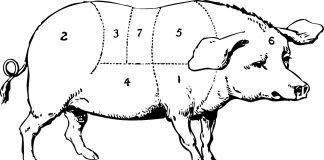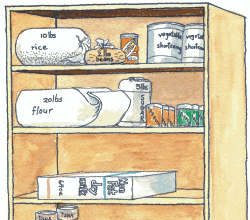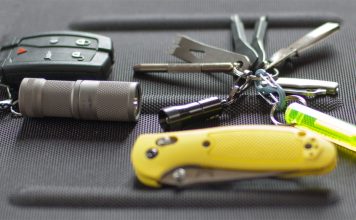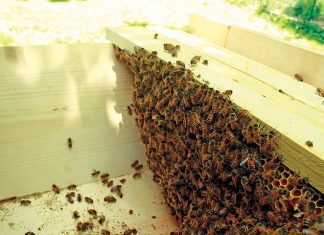 |
|
| Issue #34 • July/August, 1995 |
(This is a four-part series. Click the links to navigate to parts one, two, three, and four.)
Do I have to stay and help you?” my 12-year old son asked.
I stood by the edge of the bathtub staring at the exposed plumbing. I could feel sweat running down my face and back, though the bathroom wasn’t hot. There was a hole in the wall where I’d removed the shower fixtures, and there were tools scattered about as if they were crawling off in different directions to get away from me.
“Can I go over to my friend’s?” he asked.
I ignored him and stared at the tub. I hate home repairs. I’m not good at them.
I heard the doorbell, and my youngest yelled to say she’d get it.
“Can I go?” he asked again.
“Stay here.”
“Why?”
“I may need you.”
“I don’t know how to do this stuff,” he said. “I don’t know anything about fixing faucets.”
“I want you here, anyway. This’ll be educational. You’ll probably learn a few new words.”
“I imagine he’s learned a few already,” a voice said. I didn’t have to turn around to realize it was O.E. MacDougal, my poker playing friend.
My son looked relieved, as if Mac’s presence was going to free him.
Mac stepped into the bathroom and looked at what I was doing. “I didn’t think you did this stuff.”
“He doesn’t,” my son said.
I nodded.
“Can I go?” he asked again.
“I need you here.”
“For what?”
“I told you, I don’t know, yet.”
“Let me help,” Mac said and nodded to my boy as if to tell him to leave and my son looked at me expectantly.
“Go ahead,” I said.
I watched him run down the hall and I stared after him.
“What are you looking at?” Mac asked.
“I just didn’t know he could move that fast.”
He eased past me and sat on the edge of the tub. “What can I do to help?”
“Start pouring gasoline,” I said. “I’ll go look for matches.”
He looked at the hole in the wall. Plumbing extended from it like broken bones. “How long have you been working on it?”
“All morning,” I said. “And I don’t have time for it. I’m so far behind, I feel like quitting.”
“Behind on the magazine?”
“Yeah.”
“What are you writing about this issue?”
“Nothing. I don’t have time.”
“Have you ever done this kind of repair before?”
“Never.”
He was peering into the hole. “Are these the tools you’ve got?”
“You see ’em all. Why don’t you move over here so I can get back in there.”
“Let me take a look at it first.” He felt around in the hole. “Do you have needlenose pliers?”
I gave him a small set that was pitted and rusted and that resisted efforts to open or close them. He could have quit right then and there, or at least have expressed his disapproval. Instead, he went to work.
I’m not sure what he did. He removed a little doodad and put it on the side of the tub. “I was kind of hoping you’d do more on the First Ladies,” he said.
“What?”
“You said you aren’t writing anything this issue and I was hoping you’d do more on the presidential wives.”
“I don’t have time. Besides, I’ve forgotten all about that. I can’t even remember where I left off.”
“The last one you wrote about was Julia Grant, Ulysses S. Grant’s wife.”
“Oh.”
He looked around the floor.
“What are you looking for?”
“Pliers.”
I moved a towel. “Right there.”
He used the pliers to tug on the fixture and a bigger doodad came out. He looked at it. “The next First Lady was pretty interesting,” he said.
“Who was that?”
“Lucy Hayes, the wife of Rutherford B. Hayes.”
“What was she like?”
He kept looking at the doodad. “You need a new one of these.”
I leaned over and looked at it. “Where do you get ’em?”
“Let’s go.”
Next thing I knew, we were in his car heading for the hardware store. I wasn’t sweating anymore. I was going to ask him how he got the fixture out, but I really didn’t want to know.
Lucy Hayes
“Lucy Hayes,” he said.
“Who?”
“Lucy Hayes was the next First Lady. To understand her you should know something about the times she lived in. It was the last half of the nineteenth century and the lot of women was changing. They were assuming more responsibilities outside of the house and with the opening of the great mills in the northeast they were more likely to take a job outside the home, or off the farm. Still, the growth of opportunities was slow. So slow, in fact, that many women went to Europe for their educations because it was easier for them to get one there. At the same time, a lot of the national organizations that were intended to support and to foster women’s causes were being formed.”
“Like, which ones?”

Lucy Ware Webb Hayes
“The Women’s Christian Temperance Union, the National Association of Colored Women’s Club, the P.T.A….”
“The P.T.A. isn’t a woman’s organization.”
“It was then, and still is, staffed mostly by women, and it was a vehicle for opening up opportunities for them.”
“Oh.”
“It was against those times that Lucy became First Lady, and she was the first one to have a college education.”
“She was?…the very first?”
“Yes. But don’t get the idea she was brighter than the ones who preceded her. Many of those women were extremely bright.”
“But if it was so tough for women to get an education back then, how’d she get hers?”
“After her father died, her mother moved the family to Delaware, Ohio. That’s where Ohio Wesleyan College is. She wanted her boys to get an education. She didn’t really think about educating Lucy, but when she saw how bright she was, she enrolled her in Wesleyan Female College in Cincinnati.
“By the time she graduated she was engaged to a family friend, an attorney named Rutherford B. Hayes, and a few years later they got married.
“Women were still pretty much tied to their husbands then. They had trouble buying property, they couldn’t vote, and nobody would loan them money.
“After her marriage, one of Rutherford’s sisters took her to lectures by feminists of the day. After one of those lectures, about women’s wages, she wrote her husband a letter in which she defended the use of violent methods to achieve parity with men.”
“Wow, I didn’t realize women considered that then.”
“Most didn’t. Lucy did.”
“So, how much influence did she exert on the women’s movement when she became First Lady?”
“None.”
“Why?”
“Other matters were more pressing to her. Her kids were born, her husband’s career began to take off, they had eight childrenthree of them died….”
“Three died? That would devastate a family nowadays. How did people live with it back then?”
He shrugged. “It was one of those things they had to deal with. That’s why I say you’ve got to understand the times in which people lived if you expect to understand the people themselves. It gets a little easier to understand how Lucy’s views changed when you see what she confronted.
“But, getting back to her, when the Civil War began, her husband enlisted on the Union side and led a contingent of troops from Ohio. He only served in the war for two years but he was wounded several times and rose to the rank of general. She often visited his camps, sometimes taking their children along. On one of those occasions, after she’d nursed him back to health, she stayed on to nurse other troops. To Hayes’ soldiers, she became known as Mother Lucy.
“One of her children, a son, even died during a visit. She shipped his remains back home to Ohio, but stayed in camp to be by her husband’s side.
I tried to find some meaning in that but I couldn’t. “Why was he only in the war for two years?” I asked.
“Before it ended, he was elected to Congress and they went to Washington.
“He became a loyal party man, and after the war he was one of the members of the House who voted for Andrew Johnson’s impeachment when Republicans felt Johnson wasn’t doing enough to punish the South. Later, he was elected governor of Ohio. With his war record and political successes he was a rising star in the Republican Party. By 1876, because of scandals in Grant’s administration, Grant wasn’t renominated. The party instead chose Hayes to oppose the Democrat, Samuel Tilden.
“But the election wasn’t easy. When the returns were counted, Hayes and other Republicans thought Tilden had won.”
“Why?”
“Tilden, had won a quarter-of-a-million more votes out of the 8 million that were cast and he seemed to have won one more electoral vote. But because of irregularities in the electoral college, one vote was in dispute so no winner was declared. Congress set up a commission to resolve the tie. Since the Republicans controlled Congress, the commission was staffed by eight Republicans and seven Democrats. They decided 8-7 to award the electoral vote to Hayes and he became president.”
“Do I smell a rat?” I asked.
“You smell politics.”
“So, what kind of a First Lady did Lucy make?”
“She was the first president’s wife upon whom the title of First Lady was bestowed and we’ve used it for the wives of presidents’ ever since. Unlike a lot of the women before her, she liked being First Lady, and just as Julia Grant had before her, she invited people from all walks of life to the White House. It was a touch of the democratic spirit that endeared her to the public. She even invited the families of the White House clerical staff to spend a Thanksgiving dinner with her and her family at the White House. Not something you’re likely to see a First Lady do today.
“As First Lady she also took an interest in orphans and the poor and frequently sent food to destitute families in the District.”
“Did she make any changes in the White House that would be visible today?”
“Sure. The most enduring is that she’s the one who started the tradition of the annual Easter Egg roll on the White House lawn. It was she who saw to it that running water was installed in the White House bathrooms and it was also when the very first White House telephone was installed.”
“What did she do to improve the lots of women?”
“Nothing. Feminist groups wanted her to lead the feminist cause, but she didn’t. She opted for the traditional First Lady’s role instead.
“Functions at the White House became very subdued. The Hayeses were teetotalers, so alcohol wasn’t served while her husband was President.”
“So, she just didn’t get involved in things,” I said.
“She did. She was was an avid follower of the politics of her day and she worked hard for the election of other Republicans. She was, in fact, the most politically astute First Lady since Sarah Polk. She just wasn’t a feminist anymore.
“After four years in the White House, the Hayeses left and went back to Ohio. But until she died, she stayed active in social affairs. In particular, she was concerned with the welfare of orphans. She advocated state support of an orphanage for children orphaned by the war, but the Democratically controlled legislature in Ohio refused to fund it. So she started her own with voluntary contributions, then got the state to take over its finances.”
“Smooth move,” I said.
“She was pretty sharp.”
About then, we pulled into the parking lot where there was a hardware store. I looked at it. I’ve lived in this small town for several years and I never even knew it was here.
Inside, Mac strolled among the aisles and bought some things that looked like newer versions of the doodads he’d pulled out of my wall. I paid for them. As we walked out he offered to buy me lunch in a restaurant a few doors down.
We slid into a booth there and he ordered coffee right off.
“Who was the next First Lady?” I asked.
Lucretia Garfield
“Next was Lucretia Garfield, the wife of James Garfield.”
“Was she an interesting woman?”
“She had an interesting life. She was miserable and it was all because of things her husband did to her or things that happened to him.”

Lucretia Rudolph Garfield
“Really?”
“Hollywood could make a movie about her and pack theaters, if anyone in Hollywood knew who Lucretia and James Garfield were. They wouldn’t even have to dramatize the story. The things that happened to them are the stuff movies are made of.”
“I’ll be honest; I never even heard of either one of them.”
“You’re one of the wonders of American education,” he said. “No, slight to you intended.”
“None taken. So, tell me about her.”
“She was the second First Lady with a college education. She and James met when they were students at the Western Reserve Eclectic Institute. They had an intermittent relationship, both as students and after they graduated. But he also courted a great many other women during this time.”
“While he was involved with Lucretia?”
“Yes. She frequently wanted to break it off but he’d always talk her out of it, and after eight years he convinced her to marry him. She had, in the meantime, become a school teacher and he had gone into politics.”
“It doesn’t sound like they had a tempestuous relationship,” I said.
“They didn’t. And it’s hard to imagine why they wanted to marry each other at all. After the wedding, he tended to his job as a legislator in Ohio and was rarely home. When war broke out, he spent two years in the Union Army and rose to the rank of general and she almost never saw him then. After the war, he was elected to Congress and his reputation as an effective legislator grew and they moved to Washington where they lived for 20 years. Even then, he was almost never home and he was often in the company of other women.”
“Was there anything going on with these other women?”
“She knew he had an affair with at least one of them.”
“Really?”
“Yes?”
“What a rat,” the waitress said. She was standing there with a coffee pot in her hand.
“What did she do about it?” she asked.
“She did what women of her day often felt they had to do. She forgave him and their marriage limped along for several more years. He felt, right from the beginning, that their marriage was a mistakeand he as much as her told so.”
“I’ll say it was a mistake,” the waitress said. “Who is this guy, anyway?”
“James Garfield.”
“Well, if he ever comes in here, I’ll shoot him.”
“I’ll tell him so,” Mac said.
She poured our coffee and left.
“Marriages rarely broke up then so, instead of leaving him, she placed the blame on herself and tried to win his approval. But it was difficult because he was never there. She once calculated that during the first four years of their marriage they’d been together less than five months.”
“Did they have any kids?”
“Five, but two of them died.”
“You know, I don’t think I know anyone with a kid that has died, but it was pretty common then, wasn’t it.”
He nodded. “Not many families saw all their children make it to adulthood, and some didn’t see any make it.
“But, as the years went by, Garfield started having reservations about how he’d treated his wife, and the deaths of their children affected him as much as they did her. He started to grow closer to her and after 15 years of marriage, he finally fell in love with her.
“How do we know all this about them?”
“She kept every written record, including all their correspondence, regardless of how it made them look. It’s all there today for anyone to see. She could have destroyed it, just as Martha Washington destroyed all the correspondence between her and George, and forever have closed that door to us. But she didn’t.”
“So, at least they lived happily ever after…didn’t they?”
He looked at me over his coffee. “He became a dark horse candidate for the Republican nomination in 1880 and was nominated on the 36th ballot. In the election, he defeated the Democratic nominee, Winfield Hancock, and suddenly Lucretia was the First Lady.”
“So, they lived happily ever after.”
He smiled. “As First Lady she took more interest in researching the history of the White House than in entertaining. She wanted to restore the White House to its original condition and she often went to the Library of Congress to research it.
“But just two months into his administration, she contracted malaria and James sent her to New Jersey to recover. At the railroad station, a mentally disturbed man was waiting. He wanted to shoot Garfield.”
“Are you kidding?”
“No. But the man changed his mind when he saw the poor, frail Lucretia. Two months later, at the same station, the same guy, a man named Charles Guiteau, waited for Garfield again…”
The waitress came back. “Are you two ready to order?” she asked.
“…and this time he shot Garfield twice.”
“Good,” the waitress said. “This story has a happy ending.”
Mac laughed. I was horrified. We ordered lunch and she left.
“Why?”
He looked at me. “Where were we?”
“Guiteau shot Garfield twice.”
“Oh, he felt he’d been denied a political appointment by Garfield. In accordance with the old spoils system of the day, all the old civil servants lost their jobs and the incoming administration filled them with their own people. Guiteau thought he’d been cheated out of a job, so he decided to kill Garfield.
“Garfield didn’t die immediately. He lived another couple of months and died in September of 1881. Lucretia’s days as First Lady, and her plans for the restoration of the White House, were over. She was devastated. Her marriage was finally coming together, she was First Lady, and her life suddenly unravelled.”
“How long was he President?”
“Not quite six months. Other than William Henry Harrison, he served the least time of any President.”
“What happened to her afterward?”
“Congress voted her a pension and the public raised money to ensure she was taken care of. She spent the rest of her life overseeing the preservation of the papers from her husband’s career. She perpetuated his memory until she died in 1918.”
“How old was she then?”
“Eighty- six.”
“This would not be a movie with a happy ending,” I said.
He smiled again.
“So, who was next?”
Ellen Arthur
“When Garfield died, Chester Allen Arthur became President. But his wife, Ellen, had died 20 months earlier. Arthur’s marriage was a contrast to Garfield’s. He was in love with his wife and her death was so devastating to him that he made the decision not to let any other woman take the position of First Lady that was denied to her by her death. As a result, his administration is the only one ever to have neither a First Lady nor an official hostess. Even Buchanan, the bachelor, had had his niece act as official hostess.
“He did have his sister, Mary McElroy, accompany him to the White House. But this was just to care for his daughter. Mary didn’t function as an official hostess. Chester acted as his own host.”
“Were there any changes in the White House while he was there?”
“The only thing worse to happen to the White House than Chester Arthur’s tenure there was its burning by the British in the War of 1812.”
“What do you mean?”
“He didn’t like the White House.”
“He didn’t like it?”
“No. And he refused to move into it until it was redecorated. He said it reminded him of a badly kept barracks. The decorator he had come in to do it was Louis Tiffany.”
“Was that the guy who created the Tiffany lamp?”
“Yes.”
“That doesn’t sound so bad.”
“You haven’t heard the whole story. As part of his redecorating scheme, he held a public auction. Anything he didn’t like went on the block. Ninety years of history was put up for sale.”
“An auction of stuff in the White House?”
“That’s right. He invited the public in and auctioned off what would nowadays be considered national treasures. This included furniture and personal items that belonged to past presidents and their familiesthings like clothes and toiletry items.”
“He must have been the worst president we’ve ever had.”
He shook his head. “He was a very capable president. He was just a lousy occupant of the White House. As president he instituted a merit system in the Civil Service and ended the spoils system. He also forced Congress to pass less restrictive immigration laws against the Chinese. He favored lowering the tariff. He was considered an honest and incorruptible president because he resisted the influence of the very powerful Republican machine that wanted to control him. But because of that, he lost his party’s support, and when his term was over, in his place they nominated James Blaine, a man they could control.”
“Was Arthur bitter about that?”
“I don’t think so. He had Bright’s disease and he knew he wasn’t likely to live long enough to complete another term.”
“Was he right?”
“He died in 1886, a year after he left office. He was just 49. Only Kennedy, of all the presidents, had a shorter life.”
The waitress brought us our meals. She gave Mac a dirty look. I figured she was still bitter about this Garfield character he’d talked about.
She left and I asked, “Who’s next?”
Frances Cleveland
“Well, for awhile, it looked as though we might have to do without a First Lady, again. The next president, Grover Cleveland, was the second bachelor elected to the White House.”
“The first being Buchanan?”
“Right. But he almost didn’t make it to the White House. During the presidential campaign of 1884, it was revealed he had an illegitimate son.”

Frances Folsom Cleveland
“But he was elected anyway?”
“Like I said, his opponent, James Blaine, was the product of the powerful Republican machine that had tried to control Arthur. The public perception of Blaine was that he was crooked. So the voters chose Cleveland. Other than the charge of illegitimacy, he was perceived as a man of principles.”
“No telling what people will vote for,” I said.
“If he ran today, there was something else about Cleveland that might impress voters.”
“What?”
“If you think convicted criminals should pay the price, when Cleveland was Erie County sheriff in New York, he personally hung two men.”
“Arghh. You mean, he was a hangman?”
“He was a sheriff who on occasion acted as the hangman.”
I started laughing. “Well, I suppose in today’s political climate that could be a big plus for him. But you’d expect to see it in a Republican.
“But wait a minute, you said he was a bachelor. That must mean he got married while he was president.”
“That’s right. A little over a year after he took office he married Frances Folsom. She was 21, he was 48.”
“Is there a little cradle robbing going on here?”
“Looks that way.”
“How’d he wind up married to a 21-year-old?”
“She was the daughter of his law partner, Oscar Folsom, who died when Frances was 11 and, even though Cleveland wasn’t her legal guardian, he directed her upbringing after Folsom died, even making sure she went to college. People thought, because of the interest he showed in the family, he was going to wind up married to the widow.”
“I’ll bet they were surprised,” I said.
“Both Washington society and the press were caught off guard.”
“So, she was the third First Lady to be college educated,” I said.
“Yes, and as her unofficial guardian, he even sent her on a tour of Europe after she graduated to round out her education.”
“How’d the public take to him marrying a woman less than half his age?”
“They loved it. She was the youngest First Lady ever and the wedding, though small, was a media event. Remember, he was the first and, so far, only president to marry in the White House. John Philip Sousa, the March King, led the Marine Band in playing the Wedding March from Mendelssohn’s Midsummer Night’s Dream, and when the couple went on their honeymoon, the press followed. Throughout both of Cleveland’s administrations, the press reported even the most trivial of news items about the couple. It was the beginning of keyhole journalism.”
“Did they have any kids?”
“Five. She was even the first First lady to have a baby in the White House. But, because he was the only two-term president whose terms were interrupted by the administration of another president, that baby was born during Cleveland’s second administration and it was their second kid. They had another born between his administrations, and here’s something you can put in your ‘gee whiz’ file: Their first baby had a candy bar named after her.”
“What was it called?”
“The Baby Ruth.”
“I thought that it was named for Babe Ruth.”
“That’s what a lot of people think.”
“Did she do anything of note while First Lady?”
“Not much. It’s worth mentioning that when Cleveland’s first administration ended, she was sure they’d be back in four years and as much as said so to the White House staff. But when his second term ended, and they were leaving the White House for good, she cried. She really didn’t want to go.”
“With their age difference, was she left as a young widow?”
“Yes. He died in 1908 when she was 43. But five years later, she became the first First Lady to remarry after having been married to a president.”
“Was it to another politician?”
“No, an archaeology professor at Princeton. She lived another 34 years and died at the age of 83.”
“Okay. Which First Lady followed her?”
“She was actually followed by two First Ladies; Harrison’s wife and the wife of McKinley, the man who was elected after Cleveland’s second administration.”
“So, tell me about Harrison’s wife.”
Caroline Harrison
“Caroline Harrison’s husband, Benjamin, defeated Grover Cleveland in the election of 1888. He received less of the popular vote than Cleveland but he won the right combination of states and got more electoral votes. By the way, you might want to note that his grandfather was William Henry Harrison, the ninth president.”
I nodded.
The waitress brought our check and dropped it on the table. She glared at us both and left.

Caroline Scott Harrison
“What kind of First Lady did she make?”
He looked at the ceiling. “She was an intelligent, well informed, and artistic woman.”
“Artistic?”
“She actually gave painting lessons in the White House while her husband was president.
“But like a lot of other First Ladies, she didn’t like the new lifestyle. She disliked the limited living quarters, the lack of privacy, and living under the public eye. So she threw herself into renovating the White House to make life there more livable. She decorated the rooms with flowers. She even had the first electric lights installed. But, because they were intimidated by the new technology, the Harrisons wouldn’t turn the lights on or off.”
“Why not?”
“They were afraid of getting shocks. Someone from the White House staff always had to be present to turn them on and off and, if no one was there to turn them off in the evening, the Harrisons let the lights burn all night.
“They also had quite an extended family living there. They brought in relatives from both sides of the family and because of the limited living quarters, she started to push through an expansion plan that would add two wings to the building. But it wasn’t until 10 years later, during Teddy Roosevelt’s administration, that they were completed. And even then it was only on a vastly reduced scale.
“What else did she do?”
“The White House had been infested with rats and she had trained dogs and ferrets brought in to kill them. She also had the rotten floors and grease encrusted walls replaced to reduce the vermin problem.”
“Are you saying previous presidents lived there with those problems?”
“Yes. She also started the tradition of the White House Christmas tree. But she was more than just a glorified housekeeper. She was also instrumental in the advancement of women’s opportunities. Lucy Hayes had started out as a feminist but became a traditional First Lady. Caroline Harrison started out as a conventional wife, but as First Lady she tried to promote opportunities for women.
“When the Sons of the Revolution, refused to allow women to join, a rival organization, the Daughters of the American Revolutionthe DARwas formed and she became its first president general. She was also asked to help raise money for Johns Hopkins Medical School in Baltimore. She agreed to do so, but only on the condition that it admitted women. Rather than lose the First Lady in their fund raising drive, they agreed.
“But her story gets cut short because, before her husband’s term ended, she died.”
“Of what?”
“Tuberculosis. She was the second First Lady to die in the White House and her death probably contributed more to her husband’s defeat in the election of 1892 than anything else.”
“How?”
“He just wasn’t interested in campaigning after she died.”
“Did he ever remarry?”
“Yes. Three years later he married one of his wife’s widowed nieces, Mary Dimmick, and together they had a daughter. But the two grown children he’d had by Caroline never forgave him for remarrying.
He looked at the check and took some money from his pocket.
“What do I owe?” I asked.
“I’ve got it.”
He left a tip and paid the bill at the register. Our waitress rang up our tab.
“Look,” she said. “I’m really sorry about your friend.”
“It’s okay,” he said and we left.
“Who’s next?” I asked when we got to his car.
“The next First Lady was Frances Cleveland, again, of course. Then, after her was Ida McKinley, William McKinley’s wife.”
We started back to my house.
“What was she like?”
Ida McKinley
“When she was a young womanthe woman William had met and fallen in love withshe was vivacious, beautiful, and headstrong. By the time she became First Lady her health had failed and her two daughters were dead.”
“How young did they die?”
“Katherine when she was four years old and Ida was about five months.”

Ida Saxton McKinley
I watched the scenery and listened.
“But until the day he died, McKinley was devoted to her. During the years he served as governor of Ohio, he and Ida lived in a hotel near the capitol building and every working day, twice a day, he waved to her from his window and she waved back with a white handkerchief in her hand.
“He doted on her, often leaving meetings to listen to her complaints, and in a day when there was neither radio nor television for entertainment, he spent hours reading to her.
“When they reached the White House, she was frail, sickly, and epileptic.
“She had epilepsy?”
“Yes. In fact, she had a seizure at their first inaugural ball.”
“Was her epilepsy a political drawback for him?”
“The public didn’t know about it and those of his political opponents who did were afraid that if they tried to make political hay with it it would backfire and generate sympathy for McKinley.”
“How did the McKinleys themselves keep it a secret?”
“They just didn’t talk about it. Epilepsy was a taboo subject in those days and neither they nor their guests ever mentioned it, even when she had seizures right before their eyes.”
“Did he keep her shut away?”
“It was a common practice in those days, but he didn’t do it. She attended White House functions and dinners, but he always made sure she was always seated next to him and if she had a seizure he carefully placed a napkin over her face until she recovered. They also made sure there were always escape plans in case she had an especially severe seizure.”
“How did she do as First Lady?”
“When she was able, she functioned as well as any other First Lady. When she couldn’t, her relatives and the wives of the cabinet members often helped.”
“Didn’t McKinley die in office?”
“Yes, and if you believe in women’s intuition or their powers of prognostication, when she heard her husband had been elected president, Ida had forebodings that he was going to die in office. Then, early in his second term, he was assassinated by a self- styled anarchist named Leon Czolgosz.”
“Do you believe in things like that? You know, predicting the future?”
“No.”
“Oh.
“How did she take his death?”
“She was too stunned to react when she first learned he was dying. Then, she wanted to die herself. Without him, she didn’t think there was any reason to live. Then she found one.”
“What?”
“She decided to see through the building of a mausoleum that would commemorate his life. And that’s about how long she lived. Six years later, about when it was completed, she died.”
“Who was the next presidential wife?” I asked as we pulled into my driveway. He followed me into the house and sat himself on the side of the tub and started to install the new doodad.
Edith Roosevelt
“The next First Lady was Theodore Roosevelt’s wife, Edith, but she was his second wife.”
“Second?”
“Yes.”
The doodads started going into place faster than I imagined they would.
“She and Teddy had known each other since childhood. Both their families and their friends expected them to marry each other when they grew up. But he went off to Harvard, in Massachusetts, where he met and fell in love with a woman named Alice Lee. They married in 1880.

Edith Kermit Carow Roosevelt
“Four years later she was dead, the result of complications from giving birth to their only child, a daughter he named Alice. Hours later, Roosevelt’s mother also died a few rooms away.”
“Roosevelt’s wife and his mother died the same day in the same house?”
“That’s right.”
“This all sounds like movie stuff,” I said.
He smiled. “Well, three years later, he finally married Edith and he never mentioned his first wife again. They had five more children, four sons and a daughter which Edith raised along with Alice.
“Teddy, by now, had begun a promising career in politics. He was also a successful writer of biographies and history.”
“He was a writer, too?”
“Yes. But he was kind of an oddball Republican in his time. By today’s standards he’d be regarded as a liberal Republican. He served in various positions at both the state and national level including stints as governor of New York and assistant secretary of the Navy during McKinley’s administration.
“He also raised a contingent of soldiers, called the Rough Riders, and went off to Cuba to fight in the Spanish-American War. When the war ended, he returned to the United States with the aura of a hero about himself. He became a political force in New York, but his independent views and actions in the state’s politics made him enemies, and there was a move to kick him upstairs.”
“Meaning?”
“They nominated him as McKinley’s vice presidential running mate to get him out of the state. No one expected McKinley to die in office and, when he was assassinated, the Republican Party, which was very conservative at the time, found itself with one of its most liberal members in the White House. And that’s how it happened that Edith Roosevelt replaced Ida McKinley as First Lady.”
“Tell me about her, too.”
“She was another one of the few who really loved being First Lady. But unlike so many other First Ladies who had become accustomed to delegating most of the day-to-day management of the White House, as well as the planning of White House functions, to professional housekeepers, she insisted on overseeing the details of all these tasks herself and she personally supervised the entire White House staff.
“As a result, she was personally responsible for some of the great cultural entertainment of her day being performed at the White House. Because of her, the Vienna Boys Choir, various symphony orchestras, the great pianist Paderewski, and the legendary cellist Pablo Casals performed there. She entertained painters, sculptors, poets, novelists, and historians. In spite of this, she was peculiarly without pretensions, particularly in her dress. When one high society matron said Edith dressed on less than $300 a year, and looked it, Edith took it as a compliment.”
“Down to earth, but cultured,” I said.
“You could say so. It was while she was First Lady that the White House was expanded along lines originally conceived by Thomas Jefferson, but not implemented in his time. They were the expansion plans Caroline Harrison would have liked. At the same time, some of the Victorian architecture that had been added by her predecessors was removed and the living quarters and the working quarters of the White House were finally separated assuring the privacy of presidential families. It is also because of her that there is now a corridor in the White House that’s a gallery of First Ladies.
“Edith often claimed her family was the happiest to ever occupy the White House and she was the happiest First Lady. She just may have been right.”
“Another thing she did was to inventory everything in the White House, hoping to ensure that nothing there could again be disposed of without it being noted. Oh, if only she could have been First Lady before Chester Allen Arthur had held his auction.
“When she left the White House in 1909, after their seven year tenure, she, like Julia Grant and Frances Cleveland, was sorry to go. She’d loved to have stayed on and four years later it looked as if they might come back.”
“How?”
“Her husband was dissatisfied with his successor’s administration and decided to run for the presidency again in 1912. He expected the Republicans to renominate him, but they rejected him and kept the man they already had in the White House, William Howard Taft. Roosevelt’s response was to start his own party, the Progressive Party, more popularly known as the Bull Moose Party, and he ran against both Taft and the Democrat, Woodrow Wilson.”
“He apparently didn’t win.”
“No. But he made a good showing. He finished second. But he split the Republican vote so badly that he ensured Wilson’s election and Wilson became one of only two Democrats to win the White House from the outbreak of the Civil War until the election of Franklin Roosevelt in 1932.”
“So, she never got the return trip to the White House she would have liked.”
“That’s right, and Teddy was denied the opportunity to serve more than two terms. His cousin Franklin, however, would later become the only president to try, and he succeeded.”
He turned on the faucet. Water came out. He turned it off. It didn’t leak.
“How can I thank you?” I asked.
He stood up. “We could find that boy of yours. I’ve got fishing rods in the car. Find him and let’s go.”
I wondered how fast he’d move when I called him at his friend’s.














